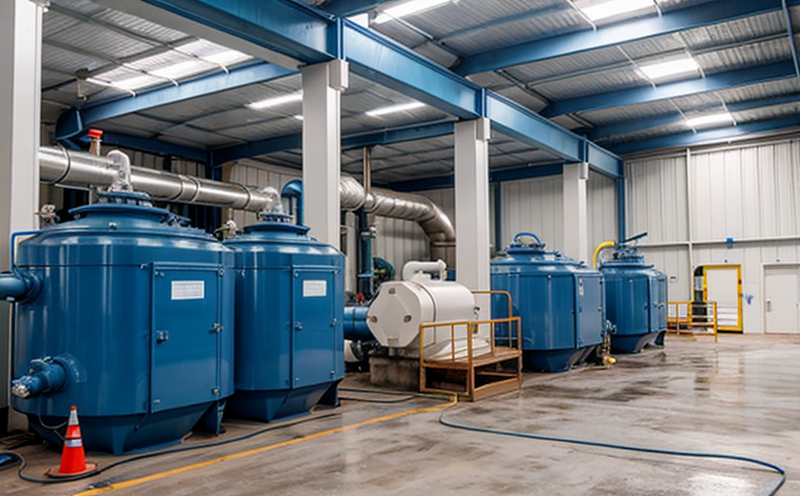DNVGL CP-0200 Ballast Water Treatment System Testing
The DNV GL CP-0200 standard is a globally recognized framework for the testing of ballast water treatment systems. This service ensures compliance with international regulations aimed at preventing the introduction and spread of invasive species through ships' ballast water, which can cause significant ecological damage. The standard requires that ballast water treatment systems are capable of reducing harmful organisms to levels specified by the International Maritime Organization (IMO).
The testing process involves a series of rigorous steps designed to evaluate the efficiency of the system in achieving these reductions. Specimens from the treated water undergo microscopic analysis using scanning electron microscopy and flow cytometry, among other techniques, to quantify the presence of microorganisms. The test apparatus includes standardized reservoirs filled with ballast water, which are then subjected to the treatment process.
Compliance with DNVGL CP-0200 is crucial for shipowners and operators who must adhere to stringent environmental standards set by global maritime authorities. This service supports their efforts in maintaining regulatory compliance while ensuring that their vessels contribute positively to environmental sustainability. The test results provide critical data needed for certification, which is essential for ongoing operations.
Testing typically involves the following stages:
- Initial sampling of untreated ballast water
- Treatment using the specified system
- Sampling and analysis of treated water
- Evaluation against DNVGL CP-0200 criteria
The acceptance criteria for passing this test are based on the reduction in viable microorganisms, as defined by the standard. This ensures that the system effectively reduces harmful organisms to levels that do not pose a risk of introducing invasive species.
Quality managers and compliance officers rely on these tests to ensure their vessels meet regulatory requirements. R&D engineers use this service to validate new technologies and improve existing systems. Procurement teams can leverage test results to select reliable suppliers for ballast water treatment solutions.
Scope and Methodology
The scope of DNVGL CP-0200 Ballast Water Treatment System Testing is comprehensive, focusing on the reduction of harmful microorganisms in ballast water. The methodology involves a series of detailed steps to ensure accuracy and reliability of results.
The testing process begins with the collection of untreated ballast water from the vessel's tanks. This sample serves as the baseline against which treated water will be compared. Once collected, the water is transported to our laboratory for immediate analysis or preservation using appropriate chemicals.
Upon arrival at the lab, the untreated samples undergo initial screening under a microscope to establish the baseline concentration of microorganisms. Next, the ballast water is subjected to the treatment process according to the specifications provided by the shipowner or manufacturer. This could involve UV radiation, chemical disinfection, or mechanical filtration.
Following treatment, further sampling occurs at various points within the system to capture representative samples for analysis. These samples are then processed using advanced analytical techniques such as flow cytometry and PCR (Polymerase Chain Reaction) to quantify the reduction in microorganism populations.
The results of these analyses are compared against the criteria set out in DNVGL CP-0200. If the reductions meet or exceed the specified thresholds, the system passes the test. Otherwise, adjustments may be necessary before retesting can occur.
Industry Applications
The application of DNVGL CP-0200 Ballast Water Treatment System Testing extends across various sectors within the maritime industry, including cruise liners, container ships, and tankers. This service is particularly valuable for:
- Cruise operators aiming to minimize environmental impact while maintaining passenger comfort
- Container ship owners seeking to comply with stringent ballast water regulations globally
- Tanker operators looking to safeguard cargo integrity by preventing contamination from invasive species
In addition, this testing is crucial for research and development (R&D) departments within shipping companies. They use the test results to innovate more efficient and effective treatment methods. Procurement teams also benefit from these tests as they provide confidence in the quality of purchased systems.
The data generated through this testing ensures that all stakeholders adhere to international standards, thereby fostering a sustainable maritime industry.
Why Choose This Test
- Comprehensive Compliance: Ensures full adherence to DNVGL CP-0200 and IMO regulations.
- Precision Analysis: Utilizes advanced analytical techniques for accurate microorganism quantification.
- Expertise: Leveraging decades of experience in marine testing, our team provides unparalleled expertise.
- Global Recognition: Compliance with this standard is widely accepted across the international maritime community.
- Rigorous Testing Process: A multi-stage approach ensures thorough evaluation and reliable results.
- Custom Solutions: Tailored testing protocols to meet specific client needs and vessel types.
- Cost-Effective: Prevents costly penalties and reputational damage from non-compliance issues.
By choosing this test, organizations demonstrate their commitment to environmental stewardship and regulatory compliance. The robust nature of our testing process guarantees high-quality results that can be trusted in court or regulatory bodies.





